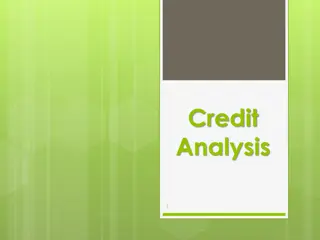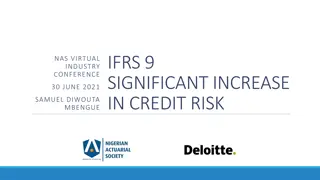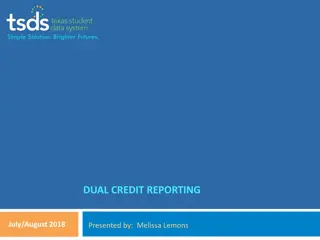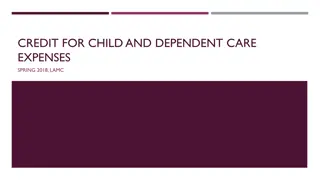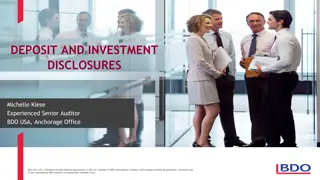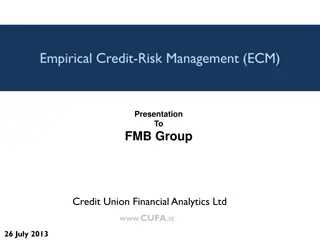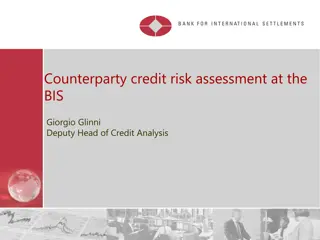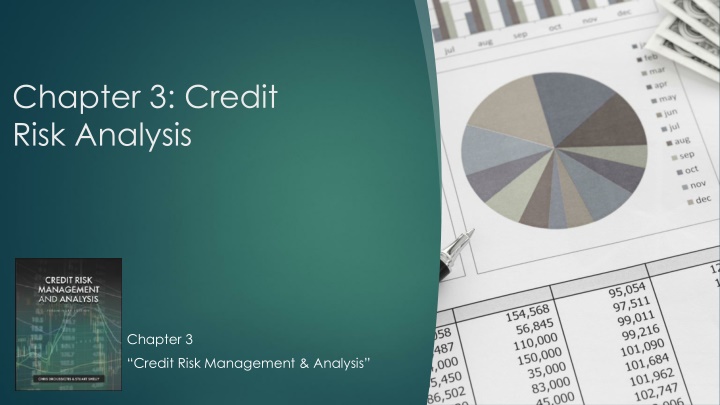
Credit Risk Analysis in Financial Management
Explore the fundamentals of credit risk analysis, client qualification, defaults, and mitigation strategies in Chapter 3 of Credit Risk Management.
Download Presentation

Please find below an Image/Link to download the presentation.
The content on the website is provided AS IS for your information and personal use only. It may not be sold, licensed, or shared on other websites without obtaining consent from the author. If you encounter any issues during the download, it is possible that the publisher has removed the file from their server.
You are allowed to download the files provided on this website for personal or commercial use, subject to the condition that they are used lawfully. All files are the property of their respective owners.
The content on the website is provided AS IS for your information and personal use only. It may not be sold, licensed, or shared on other websites without obtaining consent from the author.
E N D
Presentation Transcript
Chapter 3: Credit Risk Analysis Chapter 3 Credit Risk Management & Analysis
Credit Risk Analysis Overview Credit risk analysis involves the analysis of an obligor to determine their creditworthiness regarding their ability to repay and service (payment of periodic interest payments) a debt. The foremost consideration for repayment of a debt, is the obligor's Willingness and Preparedness to repay the debt do they have any intention of repaying the debt, and do they have the capacity to do so? 5 C s of Credit: Character see discussion of the Client Acceptance Memorandum (CAM) 1. Collateral as a second source of repayment in the event of default and the needs of the lender to satisfy the obligation through liquidation of collateral. 2. Capital adequacy of amount of funding for a business to execute its plan and sufficient investment at risk on the part of the enterprise and principals representing the borrower. 3. Capacity as determined by the collateral and debt service capability as forecast in projections and based on historical proven experience of the borrower. The Capacity C incorporates the notion of Cash, Cash Flow and Coverage Ratios (debt Service and leverage, as discussed in Chapter 1.) 4. Conditions the structure of the loan and the documentation stipulations 5. Credit Risk/Default and Loss in Event of Default The purpose of Credit Analysis is to mitigate Credit Risk
Credit Risk Analysis, Defaults & Client Qualification Default Breach of terms of any term of a credit agreement Technical e.g. filing of financial Statements on time Performance e.g. not in compliance with EBITDA maintenance levels Payment e.g. missed an interest payment Curing a Default Compliance or amendment or waiver Loss Given Event of Default Systemic exogenous risks, such as COVID19 or GFC Unsystematic due to the endogenous risks of the borrower not complying with the credit agreement, causing potential loss to the lender Remedies, such as foreclosure and collateral liquidation are inadequate Initial Client Questionnaire Client Acceptance Memo Business plan Evaluation & Assessment Memo Investment Committee Memo
Initial Client Questionnaire Who are we dealing with and what is their request of our institution? Client Name: (Stock Ticker, Name. Other) Client Principals: (CEO, Chairman, Key Officers, Founders, Equity Sponsors) Principal Place of Business Years in Business: Current Capital Base and Investors: Equity and Debt Business Description: Lines of Business: Describe the principal lines of business the company is engaged in Revenues, Gross Margin and EBITDA Financing Request: Amount Debt: Type (Revolver, term) Senior Subordinated Equity
Client Qualification & Credit Process Review of Templates Client Acceptance Memo (CAM) Assess client attributes and character as well as willingness and capacity to repay a loan See example template attached from Chapter 1 Business plan Evaluation and Assessment Memo (BEAM) Financial analysis Historical financial statements Business plan modeling and forecasting Capital structure and Debt capitalization Cash flow forecasting Ratio analysis See example attached from Chapter 1 Investment Committee Memo (ICM) Comprehensive written memo of borrower and their business and the proposed financing, including assessment of their ability and willingness to repay the loan
Collateral Analysis Primary source of repayment = Cash Flow Secondary source of repayment = Collateral Working Capital Cash & Commitments Forecast Working Capital Commitments not included in working capital CapEx Contracts Accounts Receivable Inventory Borrowing Base Eligible AR Inventory Advance rates
Collateral Analysis Primary source of repayment = Cash Flow Secondary source of repayment = Collateral Working Capital Accounts Receivable Inventory Cash & Commitments Forecast Working Capital Commitments not included in working capital CapEx Contracts Borrowing Base Eligible AR Eligible Inventory Advance rates
CASH & COMMITMENT FORECAST Growth Rate 1.33% 1.58% 1.00% 1.00% 0.00% -1.00% -1.00% 10.00% 10.00% Historical Months Forecast Months (2) (1) 0 1 2 3 4 5 6 7 Revenues COGS Gross Profit 187,500 93,615 93,885 50.07% 190,000 94,150 95,850 50.45% 193,000 96,520 96,480 49.99% 194,930 97,465 97,465 50.00% 196,879 98,440 98,440 50.00% 196,879 98,440 98,440 50.00% 194,911 97,455 97,455 50.00% 192,961 96,481 96,481 50.00% 212,258 106,129 106,129 50.00% 233,483 116,742 116,742 50.00% 50.00% SG&A Other Expenses Operating Expenses 25,445 9,525 34,970 25,470 9,525 34,995 25,500 9,525 35,025 25,519 9,525 35,044 25,539 9,525 35,064 25,539 9,525 35,064 25,519 9,525 35,044 25,500 9,525 35,025 25,693 9,525 35,218 25,905 9,525 35,430 Cash & Commitments Forecast Cash Flow From Operations 58,915 60,855 61,455 62,421 63,376 63,376 62,411 61,456 70,911 81,312 Depreciation & Amortization (add back) EBITDA 10,000 68,915 10,000 70,855 10,000 71,455 10,000 72,421 10,000 73,376 10,000 73,376 10,000 72,411 10,000 71,456 10,000 80,911 10,000 91,312 Changes in Working Capital (incl Taxes) (500) (500) (600) (386) (390) 0 394 390 (3,859) (4,245) Capital Expenditures (50,000) (75,000) (50,000) (75,000) (75,000) Purchase Orders Issued and Due in Period (2,500) (5,000) (5,000) Forecast and Committed Cash Flow Beginning Cash Forecast Ending Cash, Including Commitments 68,415 23,000 91,415 20,355 91,415 111,770 (4,145) 111,770 107,625 22,035 107,625 129,660 (2,014) 129,660 127,646 70,876 127,646 198,522 67,805 198,522 266,326 (8,154) 266,326 258,172 77,052 258,172 335,224 87,067 335,224 422,291
Collateral Analysis - AR Self liquidating - Wait and collect Depends on company status and importance Bankruptcy might destroy collection quality Ageing Invoice audit, quick method: (AR Balance / Sales) * 365 Collections History Bad debts Collection Costs Other claims Borrowing Base Eligible AR ageing, bad debts Advance rates based on: liquidation time & proceeds (net of costs) Haircut AR Facility is better quality than other debt, self liquidating and no amortization
Collateral Analysis - Inventory Inventory Where is it? What condition Raw Materials commodity, specialty goods, liquidation values Finished Goods turns (ageing) stale v immediately saleable: Inventory Turns = COGS / Inventory Days Inventory = (Inventory / COGS) * 365 Work in Process WIP Costs and infrastructure requirements to complete and time Additional resources labor, overhead, facilities, other RM Borrowing Base Eligible Inventory Advance rates based on: liquidation time & proceeds (net of costs) and haircut Borrowing Base Certificate provided by Company CFO, 30 days, Quarterly
BORROWING BASE CERTIFICATE BORROWER: Home Suites Inc. Complete the following information from the most recent Accounts Receivable Aging Summary and Blalce Sheet (both reports must be within the past 30 days) Accounts Receivable Aging Summary Date: 6/30/2021 Total Accounts Receivable Less: Inelligible Amounts Amounts over 90 Days Balance of Accounts with over 50% over 90% Accounts Exceeding Concetration Limit of 20% Total Eligible Receivables Advanced Rate (not to exceed 80%) Total Margined Receivables Amount 4,500,000 (350,000) (60,000) (750,000) 3,340,000 Collateral Analysis - Inventory 75% 2,505,000 Inventory Summary Date of Valuation or Balance Sheet: 6/30/2021 Total Inventoryh Amount Less: Inelligible Inventory Work in Progress Perishabvles Consigned Obsolete Inventory Total Eligible Inventory Amount Advanced Rate (not to exceed 50%) Total Margined Receivables Amount 800,000 (100,000) (60,000) 640,000 - 50% 320,000 Available Borrowing base Less: Current Loan Balance based on Commitment Available Funds to Borrow / (Payment) 2,825,000 5,000,000 2,175,000 For purpose of securing credit from Spring Bank NA, I hereby certify that the above information is true and correct in all material respects. This certificate is made and given in compl,iance with section 3.2 of the Loan Agreement dated March 2019 By: Date: Title:
Collateral Analysis Fixed Assets Furniture, Fixtures & equipment (FF&E) Where is it? Cost to relocate? Age & condition Liquidation Value (net of costs) Machinery & equipment manufacturing plant assets Value in use as part of going concern value Liquidation costs and Net Proceeds Mobile Assets (Transportation Assets) Tractors & Trailers Yellow Iron rail cars and locomotives (shunting locomotives) Containers, Vessels, Barges & Tugs (Jones Act, Brown Water v Blue Water) Aircraft encumbrances may have value (leased Airbus A380 to Emirates Airlines Goldman Valuation v Fortress
Collateral Analysis Fixed Assets Real Estate / Real Property Where is it? three ls of real estate Location, Location and ..Location, zoning & permits Age & condition Liquidation Value (net of costs) BPO (Broker Price Opinion) v Appraisal - Comps Specialized or Alternative Use or Cash flowing Hospital v Clean rooms v Warehouses v Office Space V Retail v School v Church v Data Center Aviation hangars unique leasehold land, restrictions & limitations v uniqueness Manufacturing plant environmental issues Intangibles sometimes very high long term value Patents & Trademarks Brands Licenses Franchises
Perfecting Security Interests Lien must be Attached to the Asset Evidence of Perfection of Security Interest Filed a Financing Statement with City, County or State Asset Interest Documentation Loan Agreement Note Agreement Security (CUSIP) Real property Mortgage County Clerk or recorders Office Tangible Personal Property Uniform Commercial Code - UCC-1 Automobiles at DMV Event of Default NOD Notice of default Remain uncured file foreclosure notice with whomever security interest was filed
Historical Financial Statement Analysis A credit analyst should review the historical financial statements (3-5 years): Collateral Analysis Historical Cash Flow Analysis - debt capacity assessment Forecast Business plan execution risk assessment. Income statement Stability and trajectory of revenues and EBITDA Cost structure (Fixed v variable) Commodity or other exogenous variable exposure Unit Economics Balance sheet Working Capital Analysis Fixed Assets Analysis - CapEx Cash flow statements Cash & Commitments, Debt Service, Other Obligations
Management Discussion & Analysis (MD&A) Em DNA Quarterly and Annual (Qs and Ks) The Credit analyst must review what is written and also interpret that which is NOT written The MD&A provide: Insight on direction and sentiment of the company Detailed analysis for prior unusual non-recurring events and forecasting Structural changes in their business economics useful for interpreting historical financial statements and developing better forecasts Credit Analysts Discussion and Analysis - CAD&A Cadennay The Credit analyst will interpret the information available through all company sources as well as that available external to the company (often from industry experts on staff or other similar companies in the same industry, suppliers or customers This is particularly important in developing costs structure, unit economics and forecasting Comprises bulk of basis for assumptions and BEAM and ISM narrative accompanying the models
Financial Forecasting Modeleing Income Statement Gross Margin We always begin our modeling with the Income Statement, in particular Revenues, COGS and the development of Gross Margin Unit Economics the foundation for the model is understanding the fundamental unit economics of the enterprise and its business What business is the Company in? Based on understanding its business and business model, the key drivers are developed The base level of the economic unit which drives the company s business Hotel rooms Airline seat passenger miles Aluminum ingots Widgets made and sold soda cans, solar panels, jet engines, consulting hours What drives the revenues and how are the units priced? What drives the costs and components of the costs tructure, including all external drivers
Financial Forecasting Modeleing Revenue Growth rate includes the combnation of two components Price - Per unit pricing Volume - Number of units sold Seasonality Current, prior and ex[ected ecominn conditions impact e.g. recession, GFC, etc. Link unit volumes and price growth to sales and marketing plans dollars spent and their expected results based on experience Requires intimate knowledge of the company business model, their customers and trends Recurring revenue, subscription versus backlog or sales plans COGS Unit economics fixed and variable costs, Components, raw materials, labor, cost of production,freight, storage and relocation costs Related to inventory, lead times and investments (Balance sheet, discussed later) (C&CF)
Financial Forecasting Modeling Sales and Marketing Plans must be provided by the company and linked to the unit sales volumes expectations, with some periodic lag component Sales and marketing, including dvertising may be prior to unit sales Commission paid concurrently with unit sales Operating Expenses (Headcount, Manufacturing and Overhead) Break headcount down by department Ensure step function of headcount is built into model can t hire a person Operations and Maintenance Especially important for capital intensive and technical businesses Power and energy Chemical plants, etc
Financial Forecasting Modeling Working Capital CPLTD Current Portion of Long term debt Accounts Receivable Collection days and ageing as well as bad debts Days Receivable = (AR / Sales) * 365 Forecasts can be sensitive to changes in collections cycles Inventory Raw Materials Work in Process Finished goods Include lead time, prepayments, relocation, storage, freight in and out, etc
Financial Forecasting Modeling Capital Assets / Fixed Assets and Capital Expenditures Consider age of equipment Sale of assets Facilties rationalization Environmental clean-up Remediations Safety standards Other necessary upgrades to meet production, technology, information, reporting, and new products Capital expenditure budgets need to be weighed regarding levels of importance and prioritized Maintenance of equipment _ capital expenditures versus operating expenses
Cash Flow Analysis - Available Measures of Cash Flow EBITDA Earnings Before Interest, Taxes, Depreciation and Amortization Intended to represent the operating cash for of the enterprise EBITDA less Working Capital and CapEx More conservative measure Operating cash flow available for debt service Debt Service Requirements Interest Expense Senior (revolver and term, tranche A, B, etc.) suborninated Amortization Schedule constant v sculpted Liquidity available from working capital revolver
Cash Flow Analysis Coverage & Ratios Debt Service Capacity Primary: EBITDA / Interest (Total Interest & Senior Only) EBITDA / Cash Interest EBITDA / P&I (Total P&I and Senior Only) Secondary operating cash flow available (EBITDA - WC CapEx) / Interest (Total Interest & Senior Only) (EBITDA - WC CapEx) / Cash Interest (EBITDA - WC CapEx) / P&I (Total Interest & Senior Only) Leverage Multiples Debt / EBITDA Debt WC, WC & term Senior Total
Structuring and Risk Mitigation Structuring the Financing is the Second most important element of Risk Mitigation After Risk-based Due Diligence Followed by Asset Management, Monitoring & Reporting (AMMR) Inspect what you Expect Leverage multiple maximum indebtedness tests using a range of leverage multples DSCR Collateral Working Capital and Liquidity Term Loan Debt Capacity
Structuring and Risk Mitigation Working Capital and Liquidity, giving consideration for: Available, eligible borrowing base debt capacity, given seasonality and liquidity needs for Capex, or other C&CF commitments Seasonality Requirements for additional capacity, including changes in turns etc Capex or other indebtedness obligations coming due imminently, Capacity to fund immediate liquidity needs by deducting the current transaction timing liquidity needs from the current drawdown under the facility. Planned maintenance and down time if necessary Growth Debt Service reserves, etc
Structuring and Risk Mitigation Term Loan debt Capacity Leverage Multiple tests DSCR Straight line constant payment analysis over typical bank term 5-7 years Flex the structure with uneven payments Backloaded tranche B term loans Sculpt the term Loan amortization Capital Markets requirements may provide structural opportunities Extended maturity term loan B tranches, etc. Capacity for planned CapEx, Integrations, etc. Ratio Analysis DSCR, Leverage and risk Tolerance Structuring DSCR and Leverage depends on risk tolerance pricing see Credit rating schedules DSCR 1.1 v 2.0, and Leverage Multiples of 2X v 4X Sculpted debt amortization is common in Project Finance and SOCs, not Leasing or Mortgage
Debt Covenants Ongoing performance covenants required by the credit agreements, of the borrower, include: DSCR and leverage ratios Financial statement and other reporting requirements Borrowing base certificate maintenance itemizing eligible collateral and advance rates formulaically and calculating the borrowing base amount the maximum amount that the revolver may be outstanding at any point in time, or at least as of the calculation date. Minimum equity Minimum cash reserves Maximum Capex The covenants are identified and negotiated with the borrower and become part of the affirmative and performance obligations of the borrower. Some covenants are conditions precedent to the funding of a Loan, like: Evidence of corporate good standing filed incorporation and paid up with their State. Evidence of permits on certificates and licenses to operate. Prior year s tax returns and audits Minimum equity Minimum cash at closing
Risk-based Due Diligence Primary Credit risk Mitigant The process of due diligence is often confused with investigation or discovery. Investigation about a company and business needs to be conducted to help the lender and the credit analyst understand the business and the potential client. Due Diligence refers to corroborating that which we already believe, understand or have been told by the company. The Credit Analyst must develop a risk-based DD program as follows: Identify threshold risks those risks, which if insurmountable or unmitigated through structure or other approach, such as warrantees or insurance, or cleaning up and obtaining an EPA audit in the case of a leaking fuel tank, would mean the Loan should not be pursued. Establish the specific investigation required to establish or confirm the status of the identified threshold risk, such as: Engage environmental consultant to complete a Phase 1 audit on the fuel tank. Establish what result or outcome of the specific procedure would be acceptable, or not: for instance, in the case of the fuel tank, an identified leak which had resulted in environmentally contaminated soil and potentially water, might suggest the Credit Analyst and Lender should not pursue the deal.
Risk-based Due Diligence Establish alternative mitigating structures or procedures which would be acceptable to cure the Identified Threshold Risk. Again, in the case of the now discovered leaking fuel tank: Completion of Phase 2 Environmental audit the funding for clean-up of contamination and commitment to clean-up evidenced by engagement of environmental clean-up service, which will warrantee their work (and which warranty is backed by surety bond of adequate amount, potentially the entire Loan amount) Adopting various structural mitigations: Springing lien on facility, which springs upon completion of satisfactory clean-up. Personal guarantees from principals, secured by funded capital until clean-up has been completed)
Pricing of Risk The Fees on a credit instrument include: Fees paid to a funding source or lender Funding Fees. Fees paid to intermediaries for arranging a loan, or security. Only the security is regulated by SEC rules, and anyone can assist a borrower in the arrangement of a loan, if they have appropriate jurisdictional licensing or approvals or are doing so as a consultant or advisor to the borrower. Arrangement Fees Fees paid to various parties for their ongoing roles in administering or managing a credit facility - Administrative Fees: Asset management, monitoring and reporting - AMMR ABL audit and Monitoring Fees Documentation Agent Fees paid to a Lender, which has the responsibility of managing Loan documentation compliance on behalf of all Lenders in a syndication.


